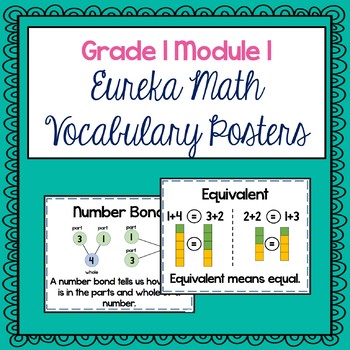Eureka (EngageNY) Grade 1 Module 1 Vocabulary
Wentz a Teacher Always a Teacher
227 Followers
Grade Levels
1st
Subjects
Resource Type
Standards
CCSS1.NBT.C.4
CCSS1.OA.B.3
CCSS1.OA.C.6
CCSS1.OA.D.7
CCSS1.OA.D.8
Formats Included
- PDF
Wentz a Teacher Always a Teacher
227 Followers
Also included in
- This bundle includes over 40 bright, colorful posters to help students visualize important concepts from the Eureka math curriculum! Designed to help visual learners succeed in the classroom, these posters are the perfect addition to the Eureka math curriculum. I have several English language learnePrice $13.00Original Price $17.50Save $4.50
Description
Designed to help visual learners succeed in the classroom, these posters are the perfect addition to the Eureka math curriculum. I have several English language learners in my classroom, and these posters are invaluable in helping those students understand the core math vocabulary presented in this unit. Simply print and enjoy!
Vocabulary posters included:
•Number Bond
•Equivalent
•Equation/Expression
•Count on
•Addend
•Doubles
•Doubles Plus One
Total Pages
Answer Key
N/A
Teaching Duration
N/A
Report this resource to TPT
Reported resources will be reviewed by our team. Report this resource to let us know if this resource violates TPT’s content guidelines.
Standards
to see state-specific standards (only available in the US).
CCSS1.NBT.C.4
Add within 100, including adding a two-digit number and a one-digit number, and adding a two-digit number and a multiple of 10, using concrete models or drawings and strategies based on place value, properties of operations, and/or the relationship between addition and subtraction; relate the strategy to a written method and explain the reasoning used. Understand that in adding two-digit numbers, one adds tens and tens, ones and ones; and sometimes it is necessary to compose a ten.
CCSS1.OA.B.3
Apply properties of operations as strategies to add and subtract. If 8 + 3 = 11 is known, then 3 + 8 = 11 is also known. (Commutative property of addition.) To add 2 + 6 + 4, the second two numbers can be added to make a ten, so 2 + 6 + 4 = 2 + 10 = 12. (Associative property of addition.)
CCSS1.OA.C.6
Add and subtract within 20, demonstrating fluency for addition and subtraction within 10. Use strategies such as counting on; making ten (e.g., 8 + 6 = 8 + 2 + 4 = 10 + 4 = 14); decomposing a number leading to a ten (e.g., 13 - 4 = 13 - 3 - 1 = 10 - 1 = 9); using the relationship between addition and subtraction (e.g., knowing that 8 + 4 = 12, one knows 12 - 8 = 4); and creating equivalent but easier or known sums (e.g., adding 6 + 7 by creating the known equivalent 6 + 6 + 1 = 12 + 1 = 13).
CCSS1.OA.D.7
Understand the meaning of the equal sign, and determine if equations involving addition and subtraction are true or false. For example, which of the following equations are true and which are false? 6 = 6, 7 = 8 - 1, 5 + 2 = 2 + 5, 4 + 1 = 5 + 2.
CCSS1.OA.D.8
Determine the unknown whole number in an addition or subtraction equation relating three whole numbers. For example, determine the unknown number that makes the equation true in each of the equations 8 + ? = 11, 5 = ▯ - 3, 6 + 6 = ▯.





